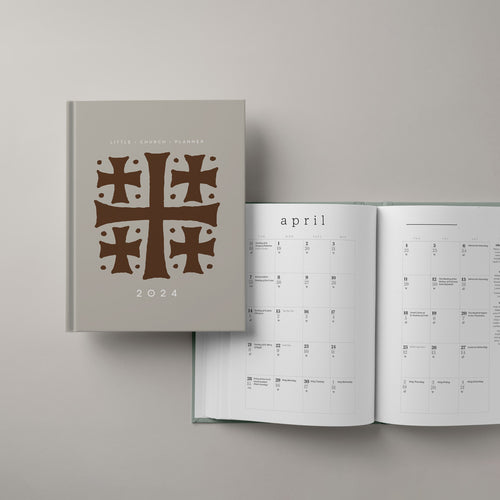
Homeschooling with the Rhythms of the Orthodox Church Year in the Mustard Seed Planner

Homeschooling is a wonderful opportunity for us to center our home-life and children's education around the rhythms of the Orthodox Church calendar, and the Mustard Seed Homeschool Planner is the perfect companion.
When we originally created Mustard Seed, it was just a homeschool planner. We knew that it would be better to have a homeschool and home-life planner in one, but that seemed an impossible task. The dream of having one place for both our schooling needs as well as a place for appointments and meal planning, however, never left our minds. Last year, we were finally able to accomplish our goal and doubled the size to include both home and school pages. Let's take a dive into the many features of the planner to help you make the most of your preparation time.
PLANS AND PRIORITIES
This is the first big-picture planning page. We have offered six categories that many of us think about and goal set for throughout the year. This is a place for you to dream about what you want to accomplish in these different areas over the course of the school year. These boxes are flexible—you can plan for yourself, your children, or your entire family. The Morning Time box, for instance, can be what you would like your personal time to look like in the morning before the children wake up, or it could be ideas for your formal Morning Time at the beginning of your homeschool day. Make it work for you.
MONTHLY NOTES
These small calendars are a quick overview of the year. We gave space under each month for you to note those important dates you need to remember as the year goes on. Family celebration days, important Church events, and reoccurring yearly appointments would all go well here. One of the things I will use this space for this year are birthdays and namedays of our godchildren. I am hoping that will help me to plan ahead and connect with them on their special days.
YEAR-AT-A-GLANCE
Just as the name suggests, this is another quick look at the year. This page is helpful because it has the longer fasting periods noted as well as all of the feast days and important holidays. This is the perfect layout to help you plan a vacation or long-term project. You will know right away if your plan for an all-you-can-eat cruise falls during a fasting time, or if you are scheduling your child's birthday party on a feast day.
INDIVIDUAL STUDENT PLANNERS
We have included six student planners at the beginning of the book to help you focus on goals and curriculum choices for each of your students. The goals section is a good place to think about each kiddo and meet them where they are. What are those skills you want to work on with them? Last year, we expanded the Student Planners to include a second page for attendance and class schedules. This is primarily for the families who have to track those things for state requirements. You may not remember what you covered in what year, so we've got your back.
CURRICULUM SHOPPING PLANNER
This page might only be used before the school year starts, but it is helpful to figure out what curriculum you need to purchase and shop around for the best deals. This stuff gets expensive! It could also be a good idea to use this page to note when your curriculum goes on sale during the year, so you will be ready with your checkbook when the time comes next year.
READING LIST AND NOTES
Here is another one of those flexible layouts for you to fit to your family. You could use it to track your family read-alouds for the year, make copies for each student to track their own reading, or use it for your personal reading list (is that a thing? Do homeschool moms get to read their own books?). You could also make a copy for each grade level and use it to track which books are to be read at each level and whether you own it or need to borrow it from the library. The possibilities are endless on this one, folks.

FESTAL STUDIES
When you purchase an Orthodox Homeschool Planner, it should help you center your school around the feast days. These festal study pages are a great way to think ahead about how you want to honor the feasts in your little church. We have gotten you started with some notes and book resources for each feast. There is still plenty of room to map out your own family traditions and recipes. There are blank Festal Study and Saint Study pages at the end for you to copy and customize with your family's namedays or other feasts. When you get them filled out, share it on social media and tag us (@parousiapress) with #planwithparousia. We would love to see everyone's ideas!

MONTHLY CALENDARS
Now that we have done the pre-work for the year, we have arrived at the meat and potatoes of the planner. The monthly layouts run from August to July. Each month, we give you the major feasts, daily fasting symbols, and reminders for what is happening that month. Most of these are notes for little 't" traditions, which just add richness to our observances and make learning about the saints and feasts a fun experience through the year.

MONTHLY DASHBOARDS
Last year, we added the monthly dashboards because we feel like the beginning of the month is a great time to reflect and have a mini reset. On the far left of the page, we revisit the six categories from the first page of the planner so you can check progress and tweak your goals and priorities each month.
The daily rhythm section helps you think about how your routine might change with the seasons. Extracurricular activities, schedule changes, as well as time and weather changes can alter how you structure your day. Life doesn't stay static, so you can make those adjustments as they happen.
The habit section could be for you or the kids. Whether you are working on making your bed or drinking water, just write your habit focuses on the lines. Each day you complete your habit, check off a box. At the end of the month you will have some visual idea of how you did and if you want to continue tracking that habit for the next month.
The Morning Time section is a great place to plan your family time for school (or in the evening if that works for your family). The daily column is for those things that don't change (prayers, Scripture reading, daily saint, read aloud, etc.). The loop is for the extra things that you like to do, but don't want to do every day. These things could include: folks songs, hymns, poetry, artist study, composer study, foreign language, handicraft, etc. You do a loop subject each day and continue to loop through your list of subjects so you touch on each thing every once in a while, but get a larger range of learning over the course of the month. We put a Morning Time section each month because you may want to change up your books or subjects as the year goes on.
It is so good to model Intercession prayers for our kids. This section gives you a place to keep your monthly family intercessions (not quite the standard 40 days). Letting the kids offer ideas for whom to pray is a great way to give them ownership over their prayers and to connect with beloved family and friends.

WEEKLY HOME PLANNERS
These are another new addition from last year and is one of the work-horse layouts. This page is for you to keep your household running whilst school is in session (and when it's not). Each day includes the saint or feast, fasting symbol, readings (from the OCA lectionary), and a place to plan daily meals. There is also a daily to-do list and a space to think about what matters most in each particular day to help you focus on what is important. This could be an appointment, prep-work that needs to be done for something coming up. an email that has to be sent, or chicken that needs to be pulled from the freezer. Whatever you need to make sure gets done that day can go in that spot.

WEEKLY HOMESCHOOL GRID
The weekly grid pages are where the magic happens for your homeschool week. There are a few ways you could go about structuring your plan. I usually put the subjects in boxes in the first column. Then I use the daily columns for what each student will be doing in that subject each day. You could use an initial next to their work or even color code each kiddo. I have three students right now, so each of them get two lines per subject per day. You could also put the student's names in the first column and list what each needs to do per day along the week. The notes section is a good place to note prep or copies that need to be made for each week, as well as library books that need to be checked out in advance.
NATIVITY FAST AND GREAT LENT
When the Nativity Fast and Great Lent occur on the calendar, there you will find them in the planner as well. These double-page spreads show the entirety of the Fast at once. This is a good place to do some fasting meal planning, plan a family almsgiving project, or note what books and activities you want to incorporate in the season. We also have a Holy Week layout to help you plan the essentials for one of the busiest weeks of the year. What is going in your Pascha basket? Are you dying eggs on Holy Thursday? Which services is your family attending? We have a spot for that. Plan ahead so you can focus on the important things when the time comes.
The last few pages of the planner offer plenty of room for your own notes, as well as an at-a-glance Fasting list for the year. There you have it! Now that you have all of the tools at your fingertips, go and make some planning magic. We would love to see what you do with the planner, so post pics and tag us @parousiapress.
Looking for more inspiration? Here is a video walkthrough of Natalia's planner with more ideas on how you can use the Mustard Seed Planner to its fullest potential.
Happy planning!











ann -
When will your little church planners be available for 2025?
THX